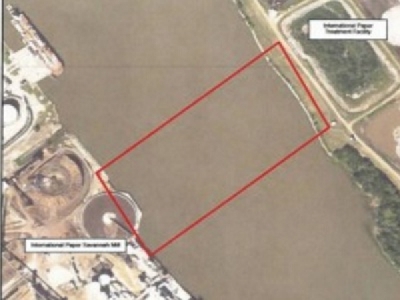
Posted on August 31, 2017
By Mary Landers, savannahnow.com
International Paper is evaluating pipelines under the Savannah River that the U.S. Army Corps of Engineers wants removed and replaced to keep them out of the way of dredging as the harbor is deepened.
Pipelines built in 1972 and 1989 connect the mill facility on Lathrop Avenue to its treatment facility on Hutchinson Island. The oldest pipe, more than three feet in diameter and made of plastic, is no longer in use. But another 3.5 foot diameter steel pipe still carries the plant’s industrial wastewater to its treatment ponds across the river. There’s also an active 10-inch electrical conduit.
“International Paper has multiple utility lines that cross underneath the river to serve their aeration lagoon,” said corps spokesman Billy Birdwell. “Some of them will need to be moved to accommodate deepening of the inner harbor.”
The joint federal/state harbor expansion project will deepen the harbor from its current 42 feet to 47 feet. An additional five feet is allowed as overdredge. The corps wants to clear the river of anything buried at a depth of less than 64 feet.
“We’ve got to make sure we don’t accidentally get into anything; we have to make sure there’s clearance,” Birdwell said. “Dredging is not an exact science. They’re working in total darkness based on instrumentation.”
The IP pipelines are the only ones the corps is aware of that must be moved. It will be putting out a public notice soon calling on the public to inform it if other such lines exist.
“We issued a similar inquiry several years ago and want to confirm that we have the most recent information,” Birdwell said.
Plans files with the Department of Natural Resources call for removing the old pipe and installing nearly a third of a mile of five-foot steel casing with a 42-inch steel carrier and conduit bundle. All the work will take place within the limits of an easement in the river granted to IP by Georgia in 1972 for $5,000. That same easement prohibits IP from seeking state or federal compensation for having to move the lines. Commercial navigation takes precedence.
“They have to get out of our way,” Birdwell said.
An IP spokeswoman declined to say how much the move would cost or if the company was paying, or even if the company agrees that the pipes must be moved.
“We are currently evaluating how the existing infrastructure at our Savannah Mill may be impacted by the Savannah Harbor Expansion Project,” said spokeswoman Karen Bogans. “We currently operate pipes under the river to transport our effluent to a treatment system. We are determining how the location of these pipes relate to the project plans. If any modifications are required, we will develop specific plans, potential costs and a schedule for implementing any required modifications.”
The Georgia DNR’s Coastal Resources Division issued a letter of permission to International Paper on July 31 outlining how the project should proceed.
It calls for a barge-mounted clamshell bucket rig to uncover the 1972 42-inch (plastic) pipeline. The excavated sediment will be left on the river bottom and used as fill for the pipeline trench left behind once the pipe is removed. The plastic pipe will be removed in sections because it’s expected to break easily. Concrete collars and blocks will also be removed. The 1989 steel lines will be removed most likely with equipment similar to a drill rig to push and pull the lines out in one piece. If that doesn’t work, regulators instruct IP to to use a clamshell bucket rig for this operation, too.
The new pipeline will be laid with trenchless horizontal directional, or micro-tunneling, technology. Because this tunnels underground rather than digging a trench, it doesn’t impact marsh and therefore doesn’t require a DNR permit or a letter of permission, said Karl Burgess of the Coastal Resources Division.
The activities cannot begin until August 15 and must be completed by Feb 1, 2018. That puts it well ahead of harbor deepening.
“Based on the current schedule, inner harbor dredging could begin in late 2018, and if we remain on schedule, it is expected to wrap up early in 2022,” said U.S. Army Corps of Engineers spokesman Russell Wicke.
Letters of permission are a kind of “permit light” meant to streamline the regulatory process. Passed in 2013 as amendments to the Coastal Marshlands Protection Act and Shore Protection Act, they authorize activity more quickly and with less opportunity for public scrutiny and objection than with beach or marsh permits. To receive a letter of permission a project must be either within the physical perimeter of an existing serviceable project or be a temporary activity.
Dave Kyler, executive director of the Center for a Sustainable Coast, said that while the time period for the pipe removal and replacement is short, its impacts could be significant.
“This, to me, is why LOPs – which now dominate in far greater numbers than actual permits at CRD – can be so pernicious,” he wrote in an email. “The standards and transparency with which ‘minimal impact’ for LOP eligibility is determined remains obscure and vulnerable to a high degree of subjectivity (i.e., political influence), without any public involvement or scrutiny of such determinations.”
Source: savannahnow





